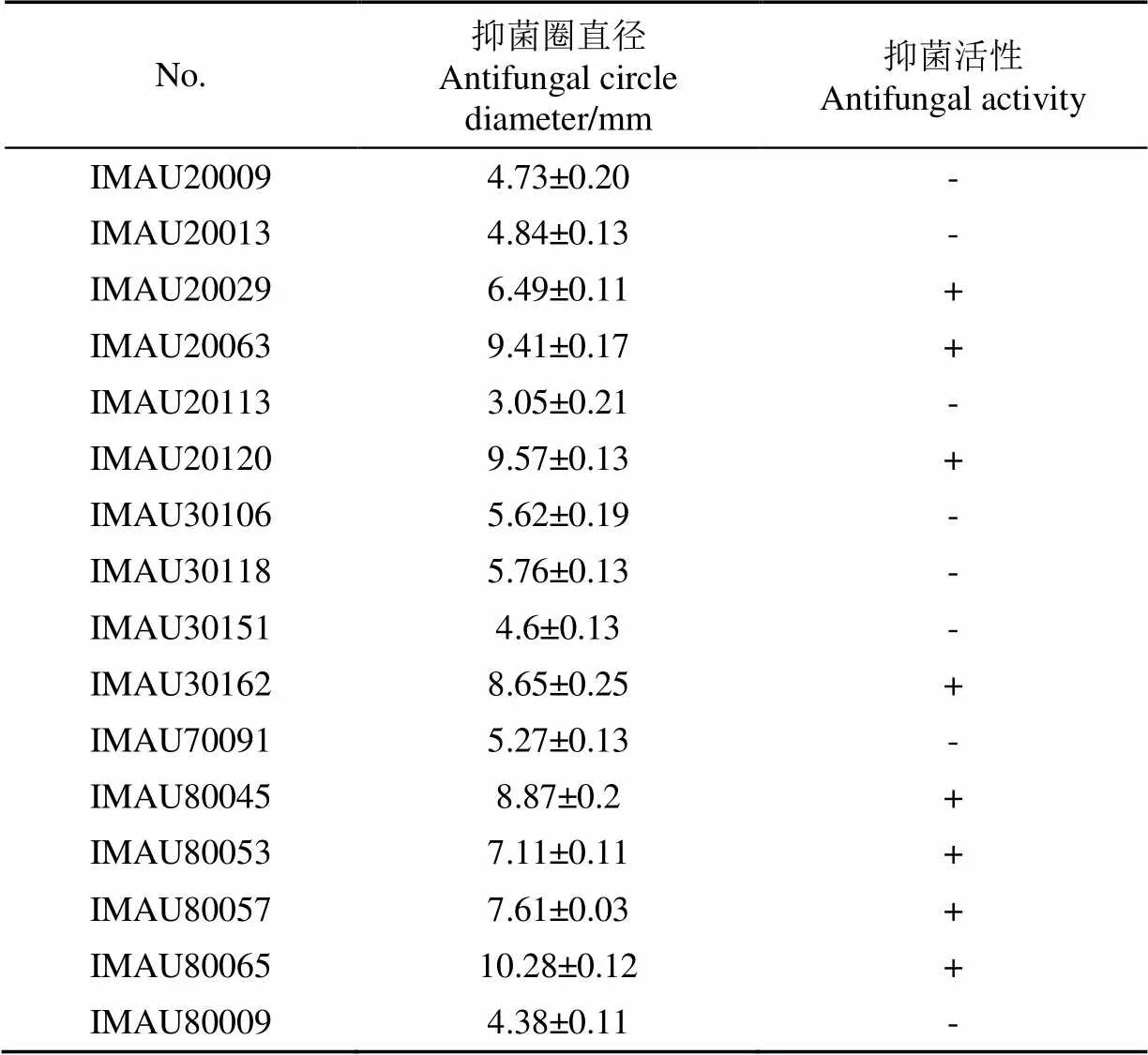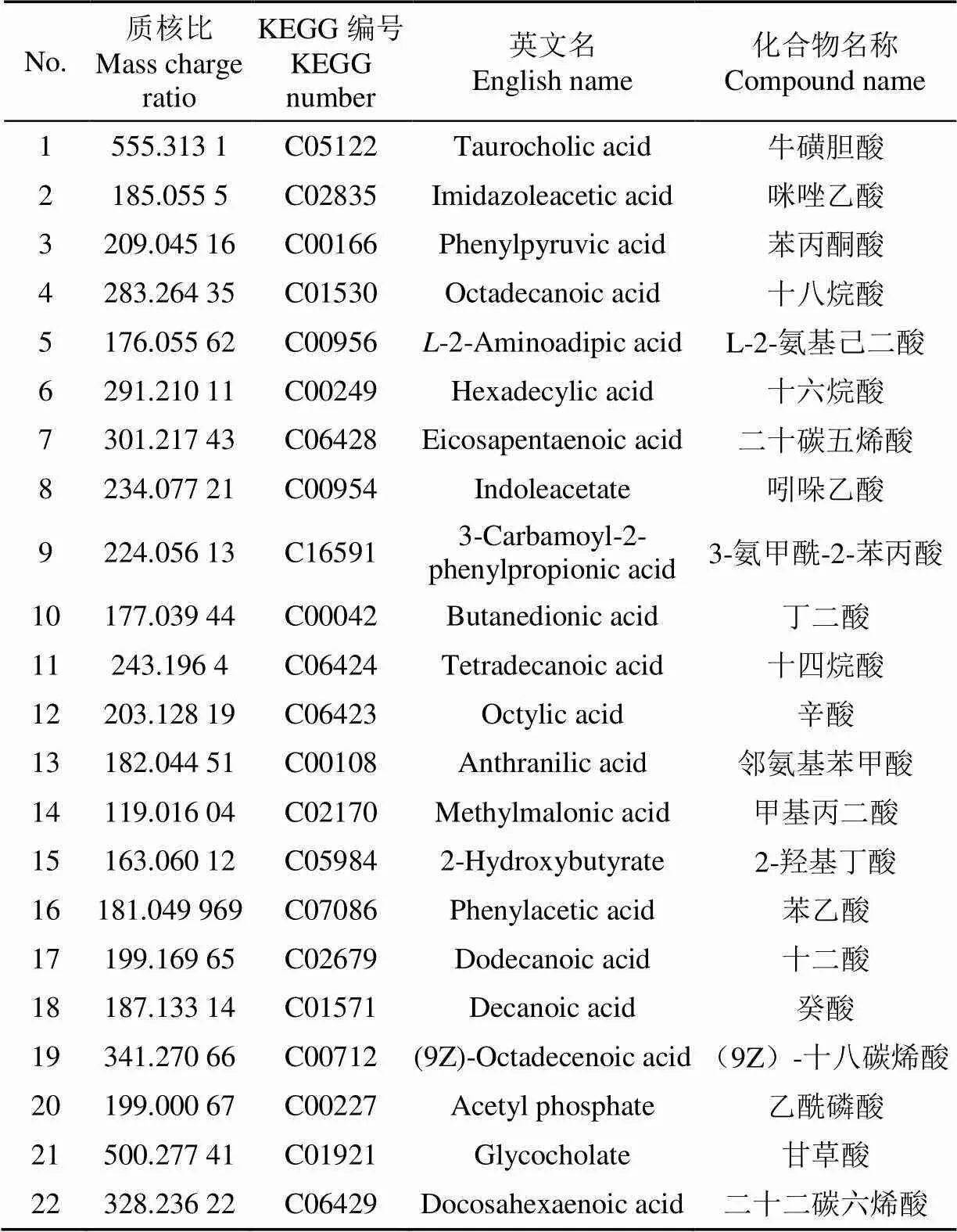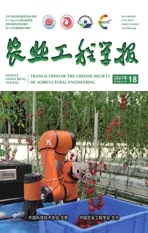植物乳杆菌抑制黄曲霉活性代谢物的初步研究
2021-11-24陈佳敏张文羿李康宁孟和毕力格
陈佳敏,张文羿,李康宁,孟和毕力格
植物乳杆菌抑制黄曲霉活性代谢物的初步研究
陈佳敏,张文羿,李康宁,孟和毕力格※
(内蒙古农业大学乳品生物技术与工程教育部重点实验室,农业农村部奶制品加工重点实验室,呼和浩特 010018)
植物乳杆菌()能够抑制黄曲霉生长,但起主要抑菌作用的物质尚未明确。该研究采用非靶向代谢组学技术比较分析了8株抑菌活性较好(S组)和8株抑菌活性较差(W组)的.发酵上清液。结果显示,两组.发酵上清液的代谢组存在显著差异(<0.05)。通过数据库比对鉴定得到咪唑乙酸、酪氨酸等30个显著差异代谢物(<0.05),其中有机酸、脂肪酸等酸性物质较多为22个。通过与已报道的乳酸菌产生的抗真菌物质相比较,找到十八烷酸、吲哚乙酸等结构一致或结构类似物,表明上清液中酸性物质起主要的抑菌作用,且其抑菌活性依赖于低 pH 值的酸性环境。在.产生的主要有机酸中,乳酸、乙酸、丙酸的抑菌活性良好,其抑制黄曲霉活性从大到小依次为丙酸、乙酸、乳酸。当乙酸浓度为2.64g/L、丙酸浓度为1.76 g/L时,可完全抑制浓度为106个/mL的黄曲霉孢子生长。综合表明,植物乳杆菌代谢物中有机酸和脂肪酸为主要抑菌物质,且抑菌活性随酸性物质浓度增大而增强。
农产品;酸;植物乳杆菌;抗黄曲霉活性;代谢产物;非靶向代谢组学
0 引 言
黄曲霉是一种食品腐败真菌,能够污染小麦、水稻、玉米等主要粮食作物。同时,黄曲霉菌可产生多种黄曲霉毒素,其中黄曲霉毒素B1在全球范围内分布最为广泛,其具有强毒性、强致癌性、强致畸性,属于Ⅰ类致癌物,对人畜健康存在严重威胁[1]。目前,全世界约10%的支气管肺曲霉病是由黄曲霉引起[2],另外黄曲霉还可以危害人的神经、皮肤系统[3]。
黄曲霉毒素可存在于食品中,过量摄入会使人畜产生不同程度的中毒,急性中毒可引起儿童生长障碍甚至致人死亡[4]。为减少黄曲霉对食品安全的影响,当前使用最多的是调节温度、喷洒农药等物理化学方法来抑制其生长,但大多数方法抑制效果不佳且影响食用者健康[1]。因此,专一性好、安全高效的生物防治法越来越受到消费者的认可与重视[5-6]。
众所周知,乳酸菌在食品中有着长期安全使用历史,在众多乳酸菌中,植物乳杆菌的抑菌特性尤为引人关注[7]。先前研究指出,植物乳杆菌产生的天然化合物可抑制真菌生长,延长多种食品的保质期[8-9]。有研究将实验室培养的植物乳杆菌产生的多肽应用于新鲜玉米种子,发现其可以显著抑制黄曲霉及孢子的生长[10]。另一项研究中,植物乳杆菌在30 ℃培养5 d后表现出有效的解毒活性并可降解玉米种子中的黄曲霉毒素B1[11]。此外众多研究指出,植物乳杆菌的抑菌活性依赖于其产生的多种代谢物[12-13],而酸是植物乳杆菌抑菌的主要原因,其中有机酸是植物乳杆菌最主要的酸性代谢产物[14]。在植物乳杆菌产生的众多有机酸中,乙酸是最有效的抗真菌代谢产物[15]。已有多位学者对植物乳杆菌发酵上清液中的有机酸成分进行分析,发现上清液有机酸中乳酸、乙酸、丙酸的含量最高[16-17]。
当前针对植物乳杆菌对黄曲霉抑制作用的研究大多集中在单菌株所产生的抑菌物质上,对具有不同抑菌活性的多菌株之间差异代谢物的研究较少。因此,本试验基于前期研究发现的具有不同抑制黄曲霉活性的16株性植物乳杆菌(其中8株抑菌活性强,8株抑菌活性弱),利用超高效液相色谱-四级杆飞行时间质谱技术结合主成分分析(Principal Components Analysis,PCA)和正交偏最小二乘法-判别分析(Orthogonal Partial Least Square-Discriminate Analysis,OPLS-DA)研究具有不同抑菌活性菌株之间的差异代谢物,从代谢角度分析其抑菌作用的组分,以期寻找确切抑制黄曲霉的小分子代谢物,为开发天然防腐剂提供依据。同时,本研究基于实验室前期定量测定的植物乳杆菌发酵上清液中乳酸、乙酸和丙酸的含量,在黄曲霉孢子数相同的情况下,分别用1、2、3倍浓度的标准品对其抑制黄曲霉活性进行验证,为植物乳杆菌的实际应用奠定一定基础。
1 材料与方法
1.1 植物乳杆菌及黄曲霉菌株来源
本试验所用的16株植物乳杆菌均由乳品生物技术与工程教育部重点实验室乳酸菌菌种资源库提供。本次抑菌试验所采用的黄曲霉菌株编号为CICC2219,由中国工业微生物菌种保藏管理中心提供。
1.2 主要试剂与仪器
甲酸(色谱级)、乙腈(色谱级)、氨水(色谱级),Sigema公司;乳酸标准品(色谱纯)、乙酸标准品(色谱纯)、丙酸(色谱纯),Sigma-Aldrich公司。
ACQUITY UPLC-Xevo G2 QTOF MS超高效液相色谱-四极杆飞行时间质谱仪,Waters公司;Milli-Q纯水仪,Millipore公司;旋转蒸发氮气发生器,Peak公司;电热恒温培养箱,上海一恒科技有限公司;高速控温离心机,Eppendorf公司。
1.3 试验方法
1.3.1 植物乳杆菌菌株的活化、活菌数检测及无菌上清液的制备
菌株活化及活菌数检测:将16株保藏好的植物乳杆菌分别按1%接种量接种于5 mL MRS琼脂液体培养基中,在37 ℃恒温培养箱中进行24 h培养活化,然后,在MRS液体培养基中连续传代两次,接种量为1%,培养条件均为37 ℃,培养12 h使其恢复菌株活力。将恢复活力的菌株在37 ℃下培养,生长至对数期,倍比稀释后,采用MRS固体培养基平板倾注法进行活菌数检测。
无菌上清液(Cell Free Supernatants,CFS)制备:将活菌数为5×106cfu/mL的植物乳杆菌菌株接种到MRS液体培养基,37 ℃恒温静置培养24 h,8 000×离心5 min,随后,将离心得到的上清液用0.22m滤膜过滤。
1.3.2 黄曲霉培养条件及孢子悬液的制备
将黄曲霉CICC2219作为指示菌,划线接种于马铃薯葡萄糖琼脂(Potato Dextrose Agar,PDA)斜面培养基上,30 ℃培养3~4 d至孢子形成。将已灭菌的PBS缓冲液倒入长好孢子的试管中,轻微振荡,使孢子脱落,用5层无菌纱布过滤去除菌丝体得到孢子悬液。采用梯度稀释法测定孢子数,将孢子浓度调整为106个/mL备用。
1.3.3 植物乳杆菌抑制黄曲霉活性测定
采用双层平板点接法测定植物乳杆菌抑制真菌活性,将16株已恢复菌株活力的植物乳杆菌分别接种于MRS液体培养基中,37 ℃培养12 h。在直径约为90 mm的培养皿中,加入已灭菌融化的MRS,制成MRS固体培养基,待水气消失后,使用微量移液器将5L活菌数相同的植物乳杆菌菌液点接于固体培养基上,37 ℃培养24 h至圆形菌斑形成。将0.15 mL黄曲霉孢子悬液与15 mL熔化的PDA培养基充分混合,倾注在MRS培养基上,30 ℃培养3 d,量取抑菌圈直径。依据抑菌圈直径,将植物乳杆菌划分为Strong组(S组)与Weak组(W组)。抑菌圈直径>6 mm,为抑菌活性较强(+);直径<6 mm,为抑菌活性较弱(-)[17]。
抑菌圈直径=抑菌圈外径-植物乳杆菌菌斑直径
1.3.4 发酵上清液抑菌活性的测定
将发酵上清液按10%添加量加入PDA培养基中,混匀后倒入培养皿,待培养基冷凝后,在培养皿中心位置点接5L黄曲霉孢子悬浮液,30 ℃培养3 d后观察黄曲霉菌落直径,验证植物乳杆菌抑菌活性。
1.4 UPLC-Q TOF MS 分析
取1.3.1制备的无菌上清液与乙腈按1∶1的比例混合均匀,4 ℃静置20 min,振荡15 s,室温10 000×离心15 min,取上清液过滤后作为待测样本。分析条件如下:
色谱柱选用Waters BEH C18(2.1 mm×100 mm,1.7m),进样体积为5L,流速0.32 mL/min。采用梯度洗脱,正离子模式下流动相A为0.1%甲酸水溶液,流动相B为0.1%甲酸乙腈溶液;负离子模式下,流动相A为0.1%的氨水水溶液,流动相B为纯乙腈溶液;液相洗脱梯度为:0~3 min,98% A;3~9.5 min,90% A;9.5~11 min,70% B;11~13 min,90%B;13~14 min,50% B;14~15 min,98% A。
质谱条件:离子源为ESI(Election Spray Ionization)电喷雾电离,数据采集模式为正、负子模式(ES+/-),质荷比扫描范围50~1 000 m/z。毛细管电压为3.0 kV(+/-),去溶剂气温度450 ℃,去溶剂气(氮气)流量600 L/h。
1.5 数据采集与分析
采用MassLynx、Progenesis QI软件对UPLC-Q TOF MS获得的原始数据进行峰提取,峰对齐、保留时间校正等处理。采集整理的数据导入Simca 14.1软件,进行主成分分析(PCA)、正交偏最小二乘判别(OPLS-DA)分析。使用MetaboAnalyst 5.0(http://www.metaboanalyst.ca)进行统计分析与通路分析。结合OPLS-DA的VIP(变量投影重要性,Variable Importance in the Projection)值≥1、两组间差异倍数≥2和值≤0.05相结合的方法找出两组样品中显著差异性代谢物。
1.6 乳酸、乙酸、丙酸抑制黄曲霉活性验证
基于实验室前期定量测定的发酵上清液中乳酸(3.53 g/L)、乙酸(0.88 g/L)和丙酸(0.88 g/L)的含量,在黄曲霉孢子数相同的情况下分别用其1、2、3倍浓度的标准品对其抑制黄曲霉活性进行验证。将不同浓度的3 种有机酸标品与PDA培养基混匀倒入培养皿中,待培养基冷凝后,在培养皿中心位置点接5L黄曲霉孢子悬浮液,30 ℃培养3 d后观察黄曲霉菌落生长情况。
2 结果与讨论
2.1 16株植物乳杆菌抑制黄曲霉活性比较
由表1可知,16株植物乳杆菌均可抑制黄曲霉,依据其抑菌圈直径大小将其分为抑菌性强(+),即S组;抑菌性弱(-),即W组,共两组。其中菌株IMAU80065、IMAU30162、IMAU20063等8株菌对黄曲霉的抑制效果较好。
2.2 两组植物乳杆菌无菌上清液抑菌活性测定
依据抑菌试验所得结果,以纯PDA培养基为对照,按照10%(体积百分比浓度)的添加量,将无菌上清液与PDA培养基混合,测定其对真菌菌丝生长的抑制情况。结果显示(图1),S组、W组的无菌上清液均可抑制黄曲霉生长,且S组中菌株的无菌上清液抑菌活性较强。
2.3 代谢组学分析
2.3.1 OPLS-DA分析
为找到两组样品间的差异代谢产物,通过Simca 14.1软件对具有不同抑菌活性的代谢产物进行OPLS-DA分析,得出如图2所示的离散程度得分图。由图2可知,S组的样本与W组的样本能够完全区分,且组内具有一定的类聚作用。该模型的区分程度较好。
2.3.2 差异代谢产物分析
使用MetaboAnalyst在线工具过滤数据后,依据KEGG数据库的富集分析显示,与W组对照相比,S组中酪氨酸代谢、脂肪酸合成、色氨酸代谢、丙酮酸代谢、苯丙氨酸代谢、嘧啶代谢等相关的几种途径显著富集。同时,与已报道乳酸菌抑菌物质类型对测定到的物质进行对比,在16株植物乳杆菌发酵上清液中总计鉴定到30种可能与抑制真菌活性相关的物质,主要包括有机酸,脂肪酸类酸性物质、氨基酸及其衍生物。

表1 16株植物乳杆菌抑制黄曲霉活性
注:“-”为抑菌圈直径<6 mm;“+”为抑菌圈直径˃6 mm。
Note: “-” means the diameter of the inhibition zone<6 mm; “+” means the diameter of the inhibition zone˃6 mm.
迄今为止,酸性物质被认为是植物乳杆菌产生的主要抑菌物质,在S组与W组的差异代谢物中,有机酸、脂肪酸类物质最多达22种(表2)。与目前已报道的乳酸菌产生的具有抑菌活性的酸性物质相比较,发现存在多个结构一致或结构相似的物质,如2-羟基-3-甲基丁酸、3-羟基-5-十二烯酸、苯甲酸、十四烷酸、十六烷酸、辛酸、3-羟基癸酸等[18-19]。同时,吲哚乙酸的抗真菌活性已被报道[20],咪唑类物质具有良好的抗菌效果,作为农药被广泛应用[21],因此,推测烷酸、烯酸、吲哚乙酸、咪唑乙酸类物质具有一定的抑菌活性。
其他酸性物质的抑菌活性也多次被报道,其中牛磺胆酸可降低培养基的表面张力,使菌体细胞膜损坏甚至使菌体裂解,从而能很好地抑制革兰氏阳性菌[22]。苯乙酸具有很强的抑菌活性[23],十二烷酸被用作杀虫剂[24]。苯丙酮酸可转化为苯基乳酸,显著抑制大肠杆菌、金黄色葡萄球菌、扩展青霉和黄曲霉等霉菌生长的活性[25]。乙酰磷酸是细菌合成乙酸或利用乙酸的中间代谢产物[26],乙酸是乳酸菌发酵产生的小分子抑菌物质,具有较好的抑菌活性。而甘草酸、二十二碳六烯酸具有消炎作用。由此推测,这些酸性物质具有抑菌活性。

表2 有机酸、脂肪酸及其衍生物
有研究表明,植物乳杆菌无菌上清液作用于黄曲霉后,黄曲霉被显著抑制,其生长量减少32%,黄曲霉毒素产量减少91%[27],而将上清液中和处理后,这种影响被逆转。Sangmanee等[28]也指出,植物乳杆菌UM55产生的乳酸、棕榈酸、硬脂酸等酸性物质可抑制黄曲霉的生长及黄曲霉毒素的产生,这些物质与我们发现的十八烷酸、十六烷酸相一致。因此推测,这些酸性物质的协同作用是抑制黄曲霉的关键。
在差异代谢物中鉴定到的氨基酸及其衍生物中,主要以L-半胱氨酸、D-脯氨酸、L-苯丙氨酸等游离氨基酸为主,氨基酸衍生物较少,仅发现N-乙酰基-L-天冬氨酸-L-谷氨酸一个物质(表3)。其中L-苯丙氨酸代谢的副产物为苯乳酸,而苯乳酸是近年发现的一种新型天然广谱抑菌剂[29],可能与抑制黄曲霉相关。
在植物乳杆菌产生的氨基酸类抗真菌物质中,目前最认可的是环二肽类物质,也有少数多肽、蛋白类物质。Belal等[30]对植物乳杆菌IS10进行研究发现,其产生的多肽FPSHTGMSVPP对黄曲霉MD3有良好的抑菌活性。Ahmad等[31]对植物乳杆菌YML007菌株的无细胞上清液进行分析显示,1 256.6 kDa的新蛋白对黄曲霉、米曲霉具有抗真菌活性。推测这类物质可能对黄曲霉具有抑制活性但贡献较小。

表3 氨基酸及其衍生物类物质
2.3.3 乳酸、乙酸、丙酸抑制黄曲霉活性
目前认为,酸性物质主要通过营造不利于有害菌生长的低酸环境来达到抑制其生长繁殖的目的。为验证酸性物质对抑菌活性的影响,对发酵上清液进行中和处理后,发现,其抑制黄曲霉活性显著降低,表明抑菌活性物质本身为酸性或依赖于酸性环境。有机酸是植物乳杆菌最主要的酸性代谢物,其中乳酸的产量最高[14]。有研究指出,乙酸是乳杆菌最有效的抗真菌代谢产物[15]。而未解离的乳酸、乙酸和丙酸可扩散穿过细胞膜并在细胞质内积累,造成细胞内呈现酸性环境,而这种酸胁迫的抑菌机制也被广泛认可[32]。因此,本试验基于实验室前期定量测定的发酵上清液中乳酸和乙酸、丙酸的含量,在黄曲霉孢子数相同的情况下,分别用1倍、2倍、3倍浓度的标准品对抑菌活性进行验证。发现抑菌活性从大到小依次为丙酸、乙酸、乳酸(图3),乙酸浓度增加为3倍时可完全抑制黄曲霉,丙酸浓度为2倍时即可完全抑制其生长。
3 结 论
1)本试验采用UPLC-Q TOF MS 技术,研究了16株(两组)具有不同抑制黄曲霉活性的植物乳杆菌发酵上清液的代谢组。结果发现,抑菌活性好的S组与抑菌活性较差W组间有明显差异(<0.05)。结合数据库检索及质谱信息匹配,共筛选出十八烷酸、十六烷酸、L-苯丙氨酸、吲哚乙酸、癸酸等30个代谢物,其中包含多种具有抑菌作用的有机酸。
2)试验表明,起主要抑菌作用的为酸性物质,且其抑菌活性为各种物质的共同混合作用,其抑菌活性依赖于低pH值下构建的酸性环境。本研究验证了植物乳杆菌发酵上清液中3种主要有机酸(乳酸、乙酸、丙酸)可有效抑制黄曲霉,且其抑菌活性从大到小依次为丙酸、乙酸、乳酸。
[1] 张学雯. 高效黄曲霉拮抗菌的筛选, 抑菌机理,发酵工艺条件及应用研究[D]. 保定:河北农业大学,2019.
Zhang Xuewen. Screening of Antifungal Bacteria Against, Antifungal Mechanism, Fermentation Technological Conditions and Application of[D]. Baoding: Hebei Agricultural University, 2019. (in Chinese with English abstract)
[2] Shivaprakash M, Raees A, Arunaloke C, et al. Invasive aspergillosis by: Epidemiology, diagnosis, antifungal resistance, and management[J]. Journal of Fungi, 2019, 3(5): 55.
[3] 宫安东. 镰刀菌和黄曲霉菌生防菌的分离及拮抗机理研究[D]. 武汉:华中农业大学,2015.
Gong Andong. Isolation and Antagonistic Mechanism Analyses of Biocontrol Agents Againstand[D]. Wuhan: Huazhong Agricultural University, 2015. (in Chinese with English abstract)
[4] Wu F, Groopman J D, Pestka J J. Public health impacts of foodborne mycotoxins[J]. Annual Review of Food Science and Technology, 2014, 5(1): 351-372.
[5] Kifle M H, Yobo K S, Laing M D. Biocontrol ofin groundnut using Trichoderma harzianum stain kd[J]. Journal of Plant Diseases and Protection1, 2016, 124(1): 1-6.
[6] Alaniz Z, Silvina, Barros, et al. Non-aflatoxigenicas potential biocontrol agents to reduce aflatoxin contamination in peanuts harvested in Northern Argentina[J]. International Journal of Food Microbiology, 2016, 231: 63-68.
[7] Quattrini M, Mattia S, Bernardi C, et al. Functional characterization ofITEM 17215: A potential biocontrol agent of fungi with plant growth promoting traits, able to enhance the nutritional value of cereal products[J]. Food Research International, 2018, 106: 936-944.
[8] Axel C, Brosnan B, Zannini E, et al. Antifungal sourdough lactic acid bacteria as biopreservation tool in quinoa and rice bread[J]. International Journal of Food Microbiology, 2016, 239: 86-94.
[9] Muhammad Z, Ramzan R, Abdelazez A, et al. Assessment of the antimicrobial potentiality and functionality ofstrains isolated from the conventional Inner Mongolian fermented cheese against foodborne pathogens[J]. Pathogens, 2019, 8(2): 71.
[10] Muhialdin, Belal J, Algboory, et al. Antifungal activity determination for the peptides generated byTE10 againstin maize seeds[J]. Food Control, 2020, 109: 106898.
[11] Flora O, Manjula K, Ranajit B, et al. Bio-detoxification of aflatoxin B1 in artificially contaminated maize grains using lactic acid bacteria[J]. Toxin Reviews, 2010, 29(3-4): 115-122.
[12] Abdelbar N M. Purification and characterization of an antimicrobial compound produced byEM showing both antifungal and antibacterial activities[J]. LWT-Food Science & Technology, 2019, 114: 108403.
[13] Gabriela N T, Tatiana D P. Antimicrobial Peptides fromUTNGt2 Prevent Harmful Bacteria Growth on Fresh Tomatoes[J]. Journal of Microbiology and Biotechnology, 2019, 29(10): 1553-1560.
[14] 李书鸿,柳陈坚,任贝贝,等. 不同植物乳杆菌发酵液抑菌活性及其主要有机酸组成比较[J]. 食品科学,2019,40(5):16-24.
Li Shuhong, Liu Chenjian, Ren Beibei, et al. Comparison of antibacterial activity and major organic acids in fermentation broths of differentstrains[J]. Food Science, 2019, 40(5): 16-24. (in Chinese with English abstract)
[15] Quattrini M, Liang N Y, Fortina M G, et al. Exploiting synergies of sourdough and antifungal organic acids to delay fungal spoilage of bread[J]. International Journal of Food Microbiology, 2018, 302: 8-14.
[16] 陈翠婷. 耐低温乳酸菌分离筛选及其代谢产物抑菌性研究[D]. 哈尔滨:哈尔滨商业大学,2019.
Chen Cuiting. Isolation and Screening of Low Temperature-resistant Lactic Acid Bacteria and Bacteriostasis of Its Metabolites[D]. Harbin: Harbin University of Commerce, 2019. (in Chinese with English abstract)
[17] 李康宁. 植物乳杆菌抑制真菌特性及其比较基因组学研究[D]. 呼和浩特:内蒙古农业大学,2020.
Li Kangning. Studies on Antifungal Properties and Comparative Genomics of[D]. Hohhot: Inner Mongolia Agricultural University, 2020. (in Chinese with English abstract)
[18] Ryu, Eun H, Yang, et al. Purification and characterization of antifungal compounds fromHD1 isolated from kimchi[J]. Food Microbiology, 2014, 19: 19-26.
[19] Shazia A, Bukhari, Mahwish S, Muhammad Numan, et al. Characterization of antifungal metabolites produced byandisolated from rice rinsed water[J]. Molecular Biology Reports, 2020, 47(3): 1871-1881.
[20] Siedler, Solvej, Balti, et al. Biotechnology, bioprotective mechanisms of lactic acid bacteria against fungal spoilage of food[J]. Current Opinion in Biotechnology, 2018, 56: 138-146.
[21] Bessonova E A, Deev V A, Kartsova L A. Dispersive liquid–liquid microextraction of pesticides using ionic liquids as extractants[J]. Journal of Analytical Chemistry, 2020, 75(8): 991-999.
[22] 周蔼怡,郭永文,蔡芷荷,等. 胆盐中胆汁酸含量测定的探讨[J]. 中国卫生检验杂志,2009,19(6):1427-1428.
Zhou Aiyi, Guo Yongwen, Cai Zhihe, et al. Discussion on the determination of bile acid content in bile salt[J]. Chinese Journal of Health Laboratory Technology, 2009, 19(6):1427-1428. (in Chinese with English abstract)
[23] Hwang B K, Lim S W, Kim B S, et al. Isolation and in vivo and in vitro antifungal activity of phenylacetic acid and sodium phenylacetate from[J]. Applied and Environmental Microbiology, 2001, 67: 3739-3745.
[24] Sivakumar R, Jebanesan A, Govindarajan M, et al. Oviposition attractancy of dodecanoic, hexadecanoic and tetradecanoic acids against Aedes aegypti and Culex quinquefasciatus (Diptera: Culicidae)[J]. European Review for Medical and Pharmacological Sciences, 2011, 15(10): 1172-1175.
[25] 冀慧颖,李雪儿,李明华. 苯丙酮酸生物转化产物的抑菌活性研究[J]. 广州化工,2020,48(16):61-63.
Ji Huiying, Li Xueer, Li Minghua. Study on the antimicrobial activity of biotransformation products of phenylpyruvate[J]. Guangzhou Chemical Industry, 2020, 48(16): 61-63. (in Chinese with English abstract)
[26] 郝湘妹. 抑制霉菌乳酸菌的筛选、特性及应用研究[D]. 郑州:郑州大学,2020.
Hao Xiangmei. Screening, Characteristic and Application of Lactobacillus with Antifungal Activity[D]. Zhengzhou: Zhengzhou University, 2020. (in Chinese with English abstract)
[27] Ana G, Ana S, José A, et al. Anti-aflatoxigenic effect of organic acids produced by[J]. International Journal of Food Microbiology, 2018, 246: 31-38.
[28] Sangmanee P, Hongpattarakere T. Inhibitory of multiple antifungal components produced byK35 on growth, aflatoxin production and ultrastructure alterations ofand[J]. Food Control, 2014, 40: 224-233.
[29] 宋满满,刘志国,索艳丽. 新型生物抑菌剂:苯乳酸的抑菌性研究与应用[J]. 中国饲料添加剂,2019,4:16-22.
Song Manman, Liu Zhiguo, Suo Yanli. Study and application of a new biological bacteriostatic agent: Phenyllactic acid[J]. China Feed Additive, 2019, 4: 16-22. (in Chinese with English abstract)
[30] Belal J, Mujialdina, Belaljamal, et al. Identification of antifungal peptides produced byIS10 grown in the MRS broth[J]. Food Control, 2016, 59: 27-30.
[31] Ahmad R I, Seo B J, Rejish K, et al. Isolation and characterization of a proteinaceous antifungal compound fromYML007 and its application as a food preservative[J]. Letters in Applied Microbiology, 2013, 57(1): 69-76.
[32] Lay C L, Coton E, Blay G L, et al. Identification and quantification of antifungal compounds produced by lactic acid bacteria and propionibacteria[J]. International Journal of Food Microbiology, 2016, 239: 79-85.
Preliminary study on active metabolites ofagainst
Chen Jiamin, Zhang Wenyi, Li Kangning, Menghe Bilige※
(,,,,,010018,)
Lactic acid bacteria have a long history of safe use in food. Among them, the antifungal properties ofare particularly interesting. Numerous studies have pointed out that the natural compounds produced bycan significantly inhibit the growth of fungi and, spores, thereby degrading aflatoxin, especially for the longer shelf life of a variety of food. Moreover, the acid is attributed to the antifungal activity of, where organic acid is the most important acidic metabolite of. In addition, acetic acid is the most effective antifungal metabolite among the many organic acids produced by. At the same time, there is the highest content of lactic acid, acetic acid, and propionic acid in thefermentation supernatant organic acid. However, the inhibitory effect ofonis mostly focused on the antifungal substances produced by a single strain in recent years. Only a few studies were on the differential metabolites of multiple strains with different antifungal activities. Moreover, standard products are still lacking to verify the activity of inhibitingon the quantitative amount of lactic acid, acetic acid, and propionic acid in the supernatant of. Therefore, the purpose of this research is to find the small molecular metabolites that inhibitthrough the comparison between multiple strains, with emphasis on the practical application of. 16 strains ofwith different antifungal activities were selected, 8 strains of which presented strong antifungal activity (Strong group) and the rest was weak (Weak group). Ultra-high performance liquid chromatography-quadrupole flight Time mass spectrometry combined with PCA (Principal Components Analysis) and OPLS-DA (Orthogonal Partial Least Square-Discriminate Analysis) was utilized to explore the different metabolites between strains with different antifungal activities, further to determine the substances with main antifungal effects. At the same time, standard products of 1, 2, and 3 times the concentration were used to verify the inhibit activity of, according to the quantitative determination for the content of lactic acid, acetic acid, and propionic acid in the fermentation supernatant ofin the early stage of the laboratory. The results showed that there were significantly different metabolites in the two groups offermentation supernatants (<0.05). Database comparison demonstrated 30 significantly different metabolites, including imidazoleacetic acid, tyrosine were identified (<0.05). Among them, acidic substances were relatively different, such as organic and fatty acids. Correspondingly, the acidic substance in the supernatant was attributed to the main antifungal effect, whereas the antifungal activity depended on the acidic environment of low pH value. Lactic acid, acetic acid, and propionic acid presented excellent antifungal activities among organic acids produced by. Specifically, the antifungal activity was ranked in order of propionic acid>acetic acid>lactic acid.Comprehensively, organic and fatty acids are widely expected to be the main antifungal substances, where theantifungal activity increased with the concentration of the acidic substances.
agriculture products; acid; lactobacillus plantarum; anti-aspergillus flavus activity; metabolites; non-targeted metabolomic
陈佳敏,张文羿,李康宁,等. 植物乳杆菌抑制黄曲霉活性代谢物的初步研究[J]. 农业工程学报,2021,37(18):315-321.doi:10.11975/j.issn.1002-6819.2021.18.036 http://www.tcsae.org
Chen Jiamin, Zhang Wenyi, Li Kangning, et al. Preliminary study on active metabolites ofagainst[J]. Transactions of the Chinese Society of Agricultural Engineering (Transactions of the CSAE), 2021, 37(18): 315-321. (in Chinese with English abstract) doi:10.11975/j.issn.1002-6819.2021.18.036 http://www.tcsae.org
2021-04-16
2021-08-31
国家自然科学基金(31660450):地区科学基金项目
陈佳敏,研究方向为乳酸菌资源开发与利用。Email:1259002269@qq.com
孟和毕力格,教授,博士生导师,研究方向为乳品工程。Email:mhblg@163.com
10.11975/j.issn.1002-6819.2021.18.036
TS201.3
A
1002-6819(2021)-18-0315-07
